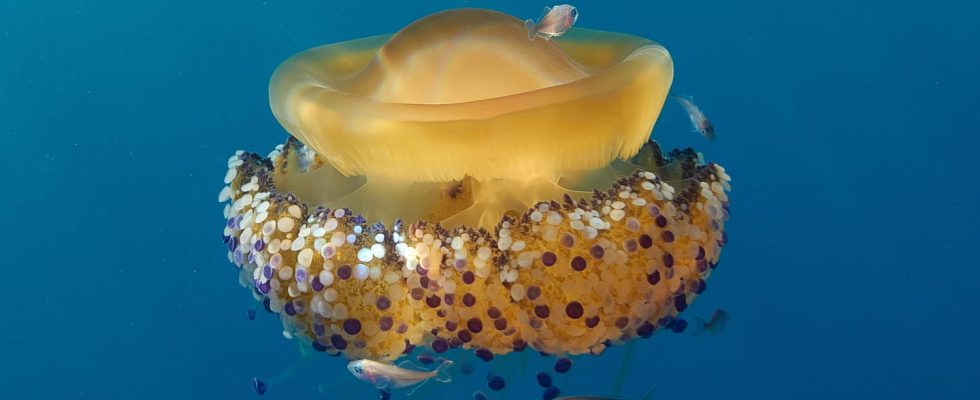A species of jellyfish is currently proliferating in the Mediterranean. The “fried egg” jellyfish has nothing to do with those we are used to seeing in France…
The summer of 2023 is announced as that of jellyfish. Images of hundreds of jellyfish washed up on Atlantic and Mediterranean beaches are already being shared on social media. If their multiplication is natural – jellyfish reproduce in winter and babies grow in spring – the winds could in particular push them en masse to the sides since June. The water, particularly warm on the coast this year, could also attract them.
On French beaches, you can mainly come across three species of jellyfish: the “compass” jellyfish, a few tens of centimeters long and covered with V-shaped brown patterns, the more bluish and transparent “Aurelia aurita” jellyfish and the rhizostome jellyfish, larger and recognizable by its umbrella bordered by a blue border. If the last two are harmless, the first can be very stinging and cause itching or even burning.

But a new species of jellyfish is proliferating in the Mediterranean and could soon hit our shores. This is the Cotylorhiza tuberculatanus, more commonly known as the “fried egg jellyfish”. A name that is not due to chance: its yellowish and domed umbrella looks like two drops of water to a fried egg.
The majestic animal, which can measure up to 35 centimeters in diameter, is considered endemic to the Mediterranean basin. In Spain, the press reports that it is invading the Minor Sea, a gigantic saltwater lagoon in the south-east of the region of Murcia. It has also been seen in Sardinia and is frequently found in summer near the coasts of the Adriatic Sea. Be always further north and closer to our coasts.
The “fried egg” jellyfish, a danger?

Slightly stinging, the sting of the fried egg jellyfish is harmless to humans. But it can cause serious burns and unexpected reactions in people with allergies. Above all, its impact on ecosystems worries scientists.
Juan Manuel Ruiz, principal researcher at the Spanish Oceanographic Institute (IEO), explained that “this increase in the number of jellyfish could be linked to human activity”, which causes an overdose of nitrates and warming currents conducive to their proliferation. “They are mostly predators, omnivores that catch their prey […] and in particular endangered species which have a role in cleaning up the sea,” he said.
